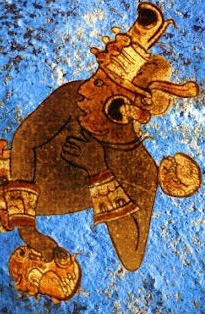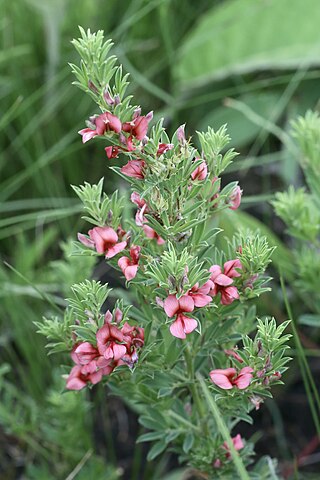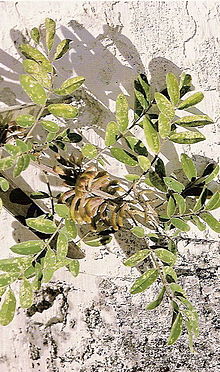
Indigo is a deep color close to the color wheel blue, as well as to some variants of ultramarine, based on the ancient dye of the same name. The word "indigo" comes from the Latin word indicum, meaning "Indian", as the dye was originally exported to Europe from India.

Indigo dye is an organic compound with a distinctive blue color. Indigo is a natural dye extracted from the leaves of some plants of the Indigofera genus, in particular Indigofera tinctoria; dye-bearing Indigofera plants were commonly grown and used throughout the world, in Asia in particular, as an important crop, with the production of indigo dyestuff economically important due to the historical rarity of other blue dyestuffs

The Fabaceae or Leguminosae, commonly known as the legume, pea, or bean family, are a large and agriculturally important family of flowering plants. It includes trees, shrubs, and perennial or annual herbaceous plants, which are easily recognized by their fruit (legume) and their compound, stipulate leaves. The family is widely distributed, and is the third-largest land plant family in number of species, behind only the Orchidaceae and Asteraceae, with about 765 genera and nearly 20,000 known species.

Denim is a sturdy cotton warp-faced textile in which the weft passes under two or more warp threads. This twill weave produces a diagonal ribbing that distinguishes it from cotton duck. While a denim predecessor known as dungaree has been produced in India for hundreds of years, denim as it is recognized today was first produced in Nîmes, France.

Isatis tinctoria, also called woad, dyer's woad, or glastum, is a flowering plant in the family Brassicaceae with a documented history of use as a blue dye and medicinal plant. Its genus name, Isatis, derives from the ancient Greek word for the plant, ἰσάτις. It is occasionally known as Asp of Jerusalem. Woad is also the name of a blue dye produced from the leaves of the plant. Woad is native to the steppe and desert zones of the Caucasus, Central Asia to Eastern Siberia and Western Asia but is now also found in South-Eastern and Central Europe and western North America.
A plantation economy is an economy based on agricultural mass production, usually of a few commodity crops, grown on large farms worked by laborers or slaves. The properties are called plantations. Plantation economies rely on the export of cash crops as a source of income. Prominent crops included cotton, rubber, sugar cane, tobacco, figs, rice, kapok, sisal, and species in the genus Indigofera, used to produce indigo dye.

Indigofera is a large genus of over 750 species of flowering plants belonging to the pea family Fabaceae. They are widely distributed throughout the tropical and subtropical regions of the world.

Indigofera tinctoria, also called true indigo, is a species of plant from the bean family that was one of the original sources of indigo dye.

Baptisia australis, commonly known as blue wild indigo or blue false indigo, is a flowering plant in the family Fabaceae (legumes). It is a perennial herb native to much of central and eastern North America and is particularly common in the Midwest, but it has also been introduced well beyond its natural range. Naturally it can be found growing wild at the borders of woods, along streams or in open meadows. It often has difficulty seeding itself in its native areas due to parasitic weevils that enter the seed pods, making the number of viable seeds very low. The plant has low toxicity levels for humans.

Maya blue is a unique bright azure blue pigment manufactured by cultures of pre-Columbian Mesoamerica, such as the Mayans and Aztecs.

Flueggea suffruticosa is a species of flowering plant in the family Phyllanthaceae. It is a deciduous shrub that is widely distributed in Asia, America, Europe, and Africa. It is one of the 50 fundamental herbs used in traditional Chinese medicine, where it has the name yī yè qiū.

Indigofera australis, the Australian indigo or Austral indigo, is an attractive species of leguminous shrub in the genus Indigofera. The genus name Indigofera is Neo-Latin for "bearing Indigo". Australis, from the Latin, means not “Australian” but "southern", referring to the geographical distribution of the species.

Natural dyes are dyes or colorants derived from plants, invertebrates, or minerals. The majority of natural dyes are vegetable dyes from plant sources—roots, berries, bark, leaves, and wood—and other biological sources such as fungi.

Dyeing is the craft of imparting colors to textiles in loose fiber, yarn, cloth or garment form by treatment with a dye. Archaeologists have found evidence of textile dyeing with natural dyes dating back to the Neolithic period. In China, dyeing with plants, barks and insects has been traced back more than 5,000 years. Natural insect dyes such as Tyrian purple and kermes and plant-based dyes such as woad, indigo and madder were important elements of the economies of Asia and Europe until the discovery of man-made synthetic dyes in the mid-19th century. Synthetic dyes quickly superseded natural dyes for the large-scale commercial textile production enabled by the industrial revolution, but natural dyes remained in use by traditional cultures around the world.

Indigofera heterantha, commonly known as Himalayan indigo, is a species of flowering plant in the legume family Fabaceae. It is native to the northwestern Himalayas of Tibet, in Asia.

Ericameria suffruticosa, the singlehead goldenbush, is a subshrub to shrub in the family Asteraceae found in the western United States. "Suffruticosa" means "shrublike".

Indigofera decora, commonly known as summer wisteria, is a species of shrub native to China and Japan that has since been introduced to Australia and Sri Lanka. A member of the genus Indigofera, its family is Fabaceae and is used primarily for decorative purposes, though it has also been used to make indigo-colored dye.

Indigofera hirsuta, the hairy indigo or rough hairy indigo, is a species of flowering plant in the family Fabaceae. It is native to nearly all the world's tropics; South America, Africa, Madagascar, the Indian Subcontinent, southern China, southeast Asia, Malesia, Papuasia and Australia, and has been introduced to the Caribbean, the southeast United States, Mexico and Central America. It is used as a green manure and, to a minor extent, for forage.

Indigofera spicata, the creeping indigo or trailing indigo, is a species of flowering plant in the family Fabaceae. It is native to Sub‑Saharan Africa, Madagascar, Mauritius, Réunion, and Yemen, and has been introduced to the southeastern United States, various Caribbean islands, Brazil and other locations in Latin America, various Pacific islands, and New South Wales and Queensland in Australia. It was considered to be a promising forage plant, and then shown to be toxic to nearly all livestock, but it is possible that the experiments were conducted on the similar Indigofera hendecaphylla, leading to some confusion.

Indigofera hilaris, the red bush indigo or gay indigofera, is a species of leguminous shrublet in the genus Indigofera.



















